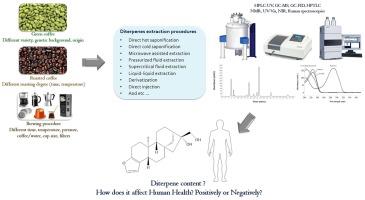Food Research International ( IF 7.0 ) Pub Date : 2020-04-02 , DOI: 10.1016/j.foodres.2020.109207 Marzieh Moeenfard 1 , Arminda Alves 2

|
The coffee oil is rich in diterpenes, mainly cafestol and kahweol, which are predominantly present in the esterified form with different fatty acids. Despite their beneficial effects including anti-angiogenic and anti-carcinogenic properties, they have been also associated with negative consequences such as elevation of blood cholesterol. Considering the coffee, it is an important human beverage with biological effects, including potentially health benefits or risks. Therefore, it may have important public health implications due to its widespread massive consumption, with major incidence in the varieties Arabica and Robusta. According to literatures, cafestol (182–1308 mg/100 g), kahweol (0–1265 mg/100 g) and 16-O-methycafestol (0–223 mg/100 g) are the main diterpenes in green and roasted coffee beans. Nevertheless, the coffee species, genetic background, and technological parameters like roasting and brewing have a clear effect on coffee diterpene content. Besides that, bibliographic data indicated that limited studies have specifically addressed the recent analytical techniques used for determination of this class of compounds, being HPLC and GC the most common approaches. For these reasons, this review aimed to actualize the occurrence and the profile of diterpenes in coffee matrices, focusing on the effect of species, roasting and brewing and on the other hand, introduce the current state on knowledge regarding coffee diterpenes determination which are nowadays highly regarded and widely used. In general, since diterpenes exhibit different health effects depending on their consumption dosage, several parameters needs to be carefully analyzed and considered when comparing the results.
中文翻译:

咖啡二萜的新趋势从技术到健康都在进行研究。
咖啡油富含二萜,主要是咖啡甾醇和卡威醇,它们主要以与不同脂肪酸的酯化形式存在。尽管它们具有抗血管生成和抗癌特性等有益作用,但它们还与不良后果(例如血胆固醇升高)有关。考虑到咖啡,它是一种重要的人类饮料,具有生物作用,包括潜在的健康益处或风险。因此,由于其广泛的大量消费,在阿拉伯咖啡和罗布斯塔品种中的发病率很高,因此可能对公共卫生产生重要影响。根据文献资料,咖啡厅酚(182–1308 mg / 100 g),卡哇尔醇(0–1265 mg / 100 g)和16- O-甲基紫杉醇(0–223 mg / 100 g)是绿色和烘焙咖啡豆中的主要二萜。尽管如此,咖啡种类,遗传背景以及诸如烘焙和酿造的技术参数对咖啡中二萜含量都有明显影响。除此之外,书目数据表明,有限的研究专门针对了用于确定此类化合物的最新分析技术,其中最常用的方法是HPLC和GC。由于这些原因,本综述旨在实现咖啡基质中二萜的出现和概况,着重于种类,烘焙和酿造的影响,另一方面,介绍了当今有关咖啡二萜测定的知识的最新状态。被认为并被广泛使用。一般来说,











































 京公网安备 11010802027423号
京公网安备 11010802027423号